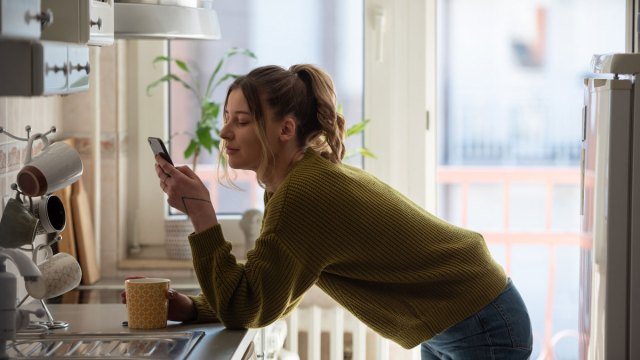It was 8 o’clock on Saturday evening. I sat on the couch with my children as they watched Pokemon. My phone dinged—a text from my husband. “Probably another hour,” he said, trying to predict his arrival time from work. I sighed and reflexively opened Instagram to refresh the Discover page—the algorithm’s interpretation of my interests, or, as I thought of it, the darkest parts of my soul. Photos of Kate Middleton. Taylor Swift. Pregnant bare-bellied women trying to dance themselves into labor. How to heal from disordered eating. How to lose 10 pounds.
I was already caught up on all my friends’ posts from the day—the photos of their cats and lasagnas, museum trips, and park play dates. One friend was on her last day at a resort in the Bahamas. I didn’t resent this; I assumed her children were melting down in the sand off-camera, just as mine had earlier in the sand pit of our own backyard.
These moments were when I consumed most of the curated content on Instagram—in occasions of miniature crisis. My youngest refused to eat the spaghetti dinner I’d made. He yelled. I took a deep breath and touched the phone in my pocket. He threw noodles to the floor. I spoke to him sternly, firm grip on my phone. Then I recovered by retreating to the kitchen alone for a quick scroll.
And when our lives were looking smooth and pretty, I snapped smiling or pensive shots to post onto my own feed. Not lying, I’d tell myself. Framing. Optimism. Art.
My husband worked most weekends, which meant that with a four-year-old and six-year-old, I worked most weekends—except I didn’t have coworkers with whom I could commiserate or shoot the breeze. And that’s when I turned to Instagram.
Recently, though, I realized that keeping company on Instagram made me feel lonely rather than connected. I didn’t want to give it up entirely—it was my primary means of corresponding with friends from high school and college. I had enough digital awareness to know that a lot of garbage could be cropped and filtered from others’ daily posts, including my own.
Still, I felt addicted. Like I was using the app compulsively. I wanted some mental real estate back. Even if it meant being totally alone with screaming children during the weekend witching hour.
I decided against a total detox. That felt too hard, like a crash diet that would result in a ravenous binge. Instead, I opted for a Sabbath. On Saturdays, my loneliest day of the week, I would stay off the app. I downloaded another app to help with this resolution. Technology to block my technology.
Here’s what I found: sitting in emotional discomfort with my children, rather than immediately fleeing, made me feel more regulated. I seemed to have more time. I embraced it by moving more slowly throughout the day.
While the boys played contentedly in our backyard, I was bored. I didn’t pull out my phone. I picked up a book of poetry. I read a single poem. It was about mothers wiping things. I thought about this poem throughout the day in a way I’m not sure I would have had I read it on an endless Instagram scroll punctuated by an advertisement for detox tea.
Later, something beautiful happened. My boys ran through a meadow of white flowers in a valley near our home. It was super Instagrammable. But I didn’t take a picture. I lingered in those additional moments just to watch, no device impeding my gaze. The light rippled across their limbs and the blades of grass. Beads of sweat dripped down their necks. I could feel the heat of the breeze on my shoulders. It was more than a single photo could have ever captured. Finally, I didn’t feel compelled to reduce it down.











